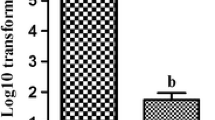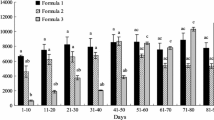Abstract
Adults of the Caribbean fruit fly, Anastrepha suspenso (Loew) were fed on three diets in order to identify one that was optimal for adult longevity, fecundity and egg viability. The diets were a dry mixture of Brewer’s (hydrolysed) yeast and sugar (Diet A); Brewer’s yeast, sugar, agar, and water (Diet B); and a dry commercial diet (BioServ) with Brewer’s yeast, sugar and casein (Diet C). There were no significant differences in per cent adult mortality among the three diets. However, the longevity of females in Diet C was significantly reduced in comparison to that of females fed the other two diets. Diet C was also suboptimal for fecundity and egg viability. Diets A and B were optimal for and had similar effects on all parameters evaluated in this study. However, Diet A appeared to be the best if preparation time and ingredient costs are considered along with biological effects.
Résumé
Des mouches à fruits adultes des Caraibes Anastrepha suspenso (Loew) furent soumises à trois régimes alimentaires dans le but d’identifier le régime alimentaire optimal pour la longévité, la fécondité et la viabilité de l’oeuf. C’était un mélange sec de levure de bière (hydrolysée) et de sucre (Régime A): levure de bière, sucre, gélose et eau (Régime B); un produit diététique sec commerçialisé (BioServ) avec de la levure de bière, du sucre de la caséine (Régime C). Du point de vue de la mortalité adulte, les trois régimes ne présentaient pas de différences remarquables. Cependant la longévité des femelles soumises au Régime C était remarquablement courte en comparaison avec celle des femelles soumises aux deux autres régimes. Le Régime C était aussi en dessous du seuil optimal pour la fécondité et la viabilité de l’oeuf. Au regard de tous les paramètres évalués dans cette étude, les Régimes A et B étaient optimaux et avaient des effets similaires. II semble cependant que le Régime A était le meilleur si l’on prend en considération, à la fois, le temps de préparation, le coût des ingrédients et les effets biologiques.
Similar content being viewed by others

References
Boggs C.L. (1981) Nutritional and life history determinants of resource allocation in holometabolous insects. Am. Nat. 117, 692–709.
Calow P. (1973) The relationship between fecundity, phenology, and longevity: A systems approach. Am. Nat. 107, 559–574.
Cavolloro R. (1981) Establishment of continuously in vitro growing cell lines of med-fly (Ceratitis capitata Wied). Rev. Can. Biol, 40, 181–186.
Cavolloro R. (1983) Fruit Flies of Economic Importance. Proceedings of the CECIIOBC International Symposium. Athens, Greece. Balkema/Rotterdam Press, pp. 642.
Doutt R.L. (1964) Biological characteristics of entomophagous adults. In Biological Control of Insect Pests and Weeds. Reinhold Pub. Co., New York. pp. 145–280.
Finney G.L. (1956) A fortified carrot medium for mass-culture of the oriental fruit fly and certain other Tephritidae. J. econ. Entomol. 134–141.
Greany P.D., Ashley T.R., Baranowski R.M. and Chambers D.L. (1976) Rearing and life history studies of Biosteres (Opius) longicaudatus (Hym.: Braconidae). Entomophaga 21, 207–215.
Hagen K.S. (1953) Influence of adult nutrition upon the reproduction of three fruit fly species. In Third Special Report on the Control of the Oriental Fruit Fly, Dacus dorsalis in Hawaiian Islands. State of California, Sacramento, California, pp. 72–76.
Hagen K.S. (1964) Nutrition of entomophagous insects and their hosts. In Biological Control of Insect Pests and Weeds. Reinhold Pub. Co., New York. pp. 356–380.
House H.L. (1962) Insect nutrition. A. Rev. Biochem. 31, 653–672.
I.A.E.A. (1975) Controlling fruit flies by the sterileinsect technique. In Food and Agriculture. Proceedings of FAOIIAEA. Division of Atomic Energy STI/PUB 392, 1–176.
Kamal A.D. (1954) Ecological and nutritional studies on the cherry fruit fly. J. econ Ent. 47, 959–965.
Lathrop G.H. and Newton R.C. (1933) The biology of Opius melleus Gahan, a parasite of the blueberry maggot. J. Agric. Res. 46, 143–160.
Lawrence P.O. (1983) Age-specific fecundity and offspring survivorship in the Caribbean fruit fly, Anastrepha suspenso after diflubenzuron treatment. Insect Sei. Applic. 4, 285–290.
Lawrence P.O., Baranowski R.M. and Greany P.D. (1976) Effects of host age on development of Biosteres (Opius) longicaudatus, a parasitoid of the Caribbean fruit fly Anastrepha suspenso. Fla. Ent. 59, 33–39.
Nakamori H. and Kakinohana H. (1980) Mass production of the melon fly, Dacus Cucurbitae Coquillett, in Okinawa, Japan. Rev. Plant Prot. Res. 13, 37–53.
Pemberton C.E. and Willard H.F. (1918) A contribution to the biology of fruit fly parasites in Hawaii. J. Agric. Res. 15, 419–467.
Sang J.H. (1959) The quantitative nutritional requirements of Drosophila melanogaster. J. Exp. Biol. 33, 45–72.
Sugimoto A. (1978) Egg collection method in mass rearing of the melon fly, Dacus Cucurbitae Coquillett (Diptera: Tephritidae). Jap. J. appl. Entomol. Zool. 22, 60–67.
Author information
Authors and Affiliations
Rights and permissions
About this article
Cite this article
Lawrence, P.O. Differential Mortality, Fecundity and Egg Viability of Caribbean Fruit Fly, Anastrepha Suspensa Adults Fed on Three Diets. Int J Trop Insect Sci 10, 353–357 (1989). https://doi.org/10.1017/S174275840000360X
Received:
Revised:
Published:
Issue Date:
DOI: https://doi.org/10.1017/S174275840000360X



